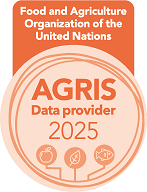Development and composition of Corriedale lamb carcasses obtained in a traditional production system
Keywords:
Corriedale, Carcass composition, Natural pasture, FeedingAbstract
Changes in carcass composition, regional and tissue component of 20 Corriedale lambs, from birth to 5 months of age were recorded. Feed level (running on natural pastures) management and production level are similar to the average in Uruguay. At 140 d of age, carcass weight was 12.35 kg. At 3 months of age, growth was slower due to low pasture quality. The study of carcass composition showed that break point for fat increase, was at 9 - 10 kg carcass weight. Allometric coeficient of growth of different regions were: loin/flank, 1.28; breast, 1.24: neck, 1.04: ribs, 1.04; leg, 1.01 and shoulder, 0.97. The coefficient for meat was 1.40 (fat, 1.87; water, 1.22; protein, 0.98), for bone, 0.80. The highest bone development was sternum, ribs, scapula and coxae. Carcass increasead in length by 60 %, width 76% and highth 43%. It is concluded that with this breed it is not possible to produce carcass of more than 10 - 12 kg without a significant increase of fat content, unless a selection program is established.











